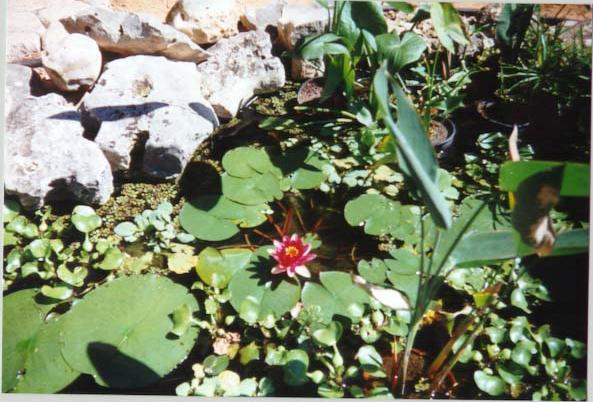![]()

![]()
The Water Garden

Gardeners are caring, sharing, nature friendly types (if they weren't, they wouldn't be gardeners) and, these days, it is quite common for anyone with the space to spare to set aside a small corner for a 'Nature Garden', a space where weeds proliferate, giving homes to a few butterflies and the odd mouse and hedgehog, and which is wonderfully labour unintensive, or else a 'Natural Pond', a habitat for, hopefully, dragonflies, frogs, newts and other crawlies which like a wet environment, and which is rather less labour unintensive. It amazes me how natural ponds, as opposed to 'Natural Ponds', work as well as they do, with their complete lack of butyl liners, oxygenating plants and carefully selected and mutually beneficial inhabitants.
And all these things are necessary if you are going to make a pond in the totally unsuitable area which you wish to turn into a 'Nature Garden'. The first thing you have to do is dig a hole. This, unfortunately, is absolutely necessary. It is the only way in which you can encourage the water with which you intend to fill it to stay in one place. If you are strong you may be tempted to start digging with a spade. If you are foolhardy, ditto. If the pond is to be a pond rather than a puddle it needs to have an area of over 40 square feet and be at least 2 feet deep (which means removing almost three tons of soil - not a job for the faint hearted). So hire a digger (and I don't mean a man with a spade). And don't forget to leave a shelf around the edge for those smaller plants or else they will disappear below the surface bubbling pathetically like alien swamp creatures on a misty night and disappear into the murky depths below.
Just digging a hole and filling it with water is not on. You finish up, not with a pond, but a wallow suitable for any passing hippopotamus. The hole must be waterproofed. You could, of course, do this with concrete. But if you have dug a hole which is an odd shape you will have to use a butyl liner. You can buy weird-shaped things which look like large kidney bowls from a garden centre, but these do restrict you as to size and shape. Yes, a butyl liner is the only thing. This will look like a rather large, rubbery groundsheet. Unfortunately, sharp stones lurking in your hole can turn your nice new liner into a rather large colander and so produce a swamp effect (which is highly undesirable) around your nice pond. So line your hole with plenty of old carpet, or two or three inches of builders sand which can be patted into place if damp - just like building sand-castles. Lay your liner in the hole and fill with water, allowing the weight of the water to drag the liner into contact with the hole underneath. I know edging around the pond would look nice, but that is a job best left for another day.
If you have inadvertently dug your hole on sloping ground, filling the pond is when the horrible truth manifests itself. The symptoms will become quite obvious - water welling across the rest of the garden taking with it mud, seedlings, the lawn, the pet rabbit and anything else which happens to be laying around.
And now, assuming that you have dug your hole on level ground and that your expensive butyl liner has not turned into an oversized sieve, comes the best bit - adding all those lovely plants and fish. But be patient. Wait a day or two for the water to settle and adjust its temperature to the surroundings. Most water plants, when you first buy them, look ominously like bits of dead twig stuck into pots of mud, and it takes quite a bit of faith to believe that such nasty looking objects will eventually turn into something as beautiful as water-lilies. Water plants need to stay in their pots and to be firmly anchored. Putting a plant in a pot into the middle of a pond without you getting very wet and without all the earth floating out of the pot is a tricky problem. It can be done by covering all the bare earth with gravel and then using two people and two long pieces of twine (or one very long piece doubled over in the middle) through holes in the pot. But do not worry unduly about this, because after all this effort the fish are quite likely to start eating the plants. And when the plants are all gone they could start eating each other. Then, once a passing heron has snapped up the remaining very fat fish, you can start all over again.
Happy Gardening.
Bill Hutchings
![]() Return to the March 1999 Features page
Return to the March 1999 Features page
![]() return to Home page and main index
return to Home page and main index
page last updated 1 MARCH 1999